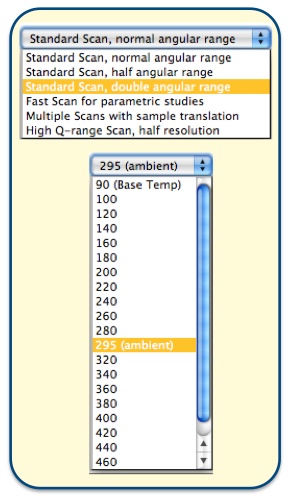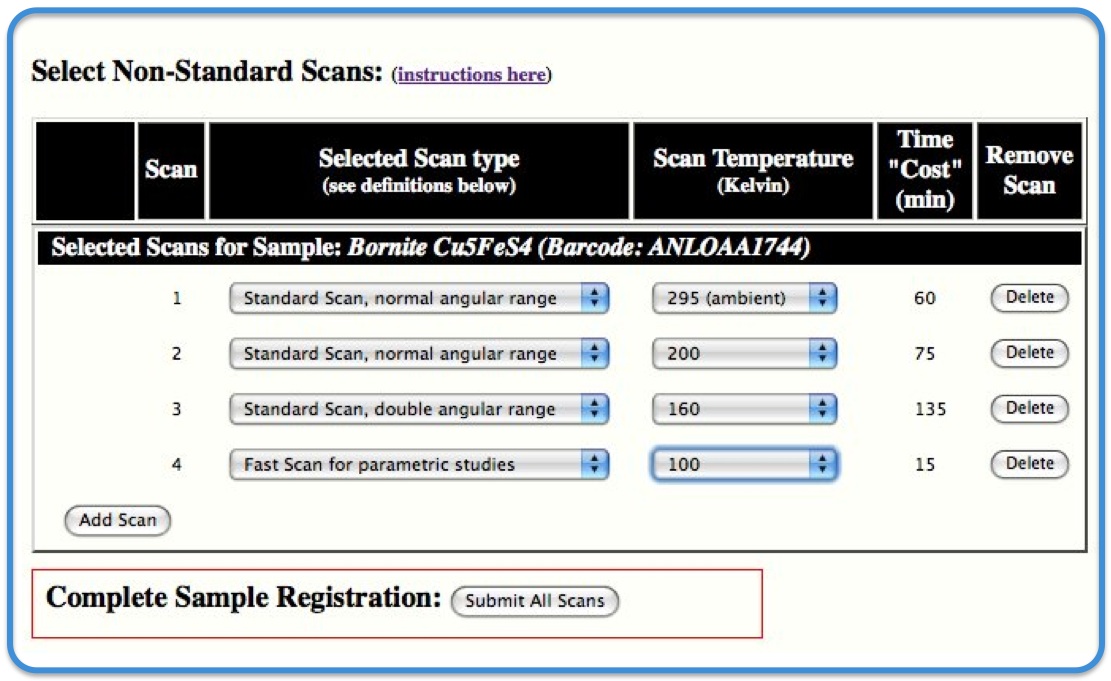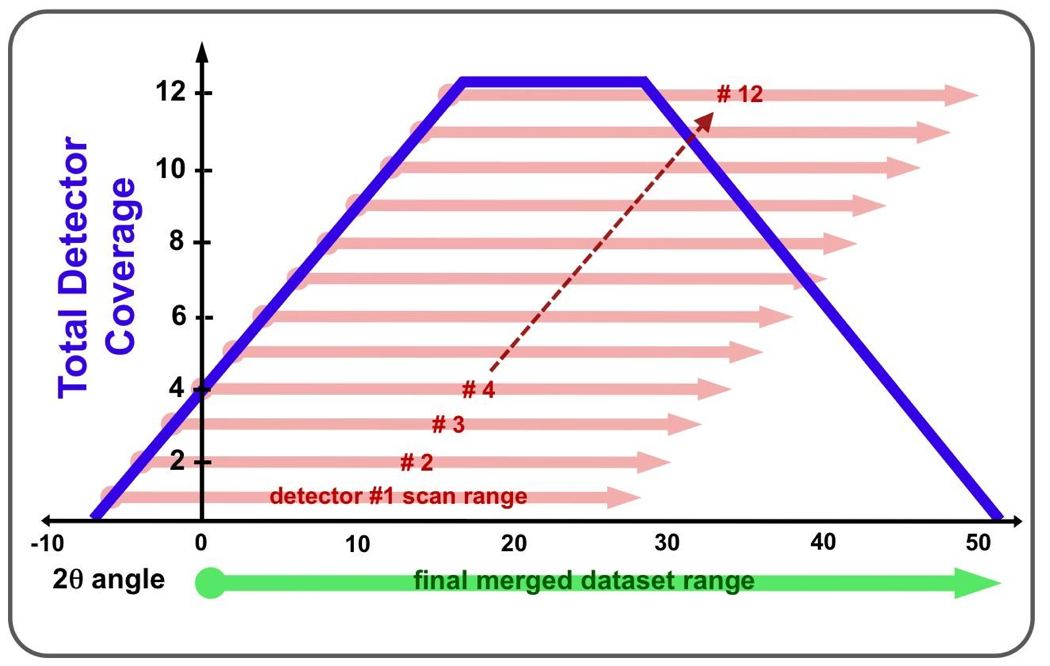 |
Advanced Photon Source |
 |
User Information
New Users
> Mail-In Instructions
> Proposal (GUP) Guide
> Beamline Description
> 11-BM FAQ
> APS: New Users
> APS: Calendar
> Mail-In Instructions
> Proposal (GUP) Guide
> Beamline Description
> 11-BM FAQ
> APS: New Users
> APS: Calendar
Current Users
> Access Database
> Mail-In Instructions
> Sample Preparation
> Data Formats
> Analysis Resouces
> Access Database
> Mail-In Instructions
> Sample Preparation
> Data Formats
> Analysis Resouces
Publishing 11-BM Results
> Report 11-BM Publications
> APS acknowledgement
> Instrument Description
> 11-BM Publications List
> Report 11-BM Publications
> APS acknowledgement
> Instrument Description
> 11-BM Publications List
|
Selecting Scan Conditions for Mail-In Samples
Mail-in users choose scan parameters for their samples during sample registration. This step must be performed before samples are returned to the APS.
Data collection conditions (e.g. scan type and temperature) are selected as shown below.
Standard scans at room temperature (Ambient) or low temperature 100 K may be selected from the pull down menu.
If 'Other' is selected from the pull down menu, users may then request alternative scan types and temperatures on a subsequent webpage after clicking the "Register Sample Info" button - see details below.
Standard Scans
Standard 11-BM mail-in scans are collected at room temperature (Ambient) or at 100 K (-173 °C). This is a ~1 hour scan. Users may collect up to 8 standard high-resolution scans per allocated rapid access beamtime shift (1 shift = 8 hours).
Merged data obtained from this scan cover the 2θ range 0.5° - 50°, with a step size of 0.001°. Mail-In samples are collected using a wavelength of ~ 0.41 Å (30 keV); therefore this scan covers a d-spacing range of 45 Å - 0.5 Å.
Standard scans are appropriate for most users, and are encouraged for new users of the 11-BM mail-in service. However, the alternative scans described below may be more appropriate for select experiments and samples.
Note: standard scans at different temperatures can be requested after selecting Other from the pull down menu. It is also possible here to request multiple variable temperature scans on a single sample.
"Other" Scans

Several alternative scan types and collection temperatures are available. Scan details may change with time according to beamline availability and user demand.
At present, the following scan types are available:
Standard: same as default ~1 hr scan described above.
Standard, half angular range: Same resolution (step size) and count time as Standard scan, but with a maximum 2θ angle of 30°. Total scan time is ~ 0.5 hour.
Standard, double angular range: Same resolution (step size) and count time as Standard scan, but with the maximum 2° angle extended to 90°. Total scan time is ~ 2 hours.
Fast scan for parametric studies: Quick scan (~ 15 min) used for screening samples and identifying transitions - lower resolution than Standard scan.
Multiple Scans with sample translation: Can be used for beam sensitive samples, 10 sequential rapid (~2 min) scans are collected with a 0.5 mm translation of the sample between scan to expose fresh powder to the beam. Multiple scans can later be manually merged to improve counting statistics - requires careful sample preparation.
High Q-range Scan, half resolution: Scan covering a large Q range (up to ~ 30 Å-1 at 30 keV). Only appropriate for strongly scattering samples - takes 2 hours.
Additional details about scan parameters are given below (explaining 2θ range, coverage etc).
All scans (include the standard scan), maybe be combined with a selected collection temperature. Temperature steps of 20 K are available in the range 100 K and 400 K. Experiments requiring greater temperature control should be performed on-site.
Requesting "Other" Scans
Users selecting Other are directed to a new webpage after clicking the "Register Sample Info" button. Specialized scan parameters and alternative scan temperatures are requested on this new page.
The scan request table (click screenshot to enlarge) consists of multiple parts descibed below.
Once all scan parameter selections are finalized, click "Submit All Scans" to complete the registration

Each user proposal has an associated number of beamtime shifts. Mail-in proposals are normally allocated 1 shift (8 hours).
The total Time Allocated for corresponding proposal is displayed in a red box at the top of the page. The Time Balance reflects the amount of beamtime remaining in the proposal. This balence includes the current requested scans for this session, all previous and scheduled beamtime at 11-BM for this proposal, and unregistered sample bases (1 hr reserved per base).
Users may not exceed the allocated time; please plan accordingly.
Contact beamline staff with questions or problems.
Explanation of "Other" Scans
Before selecting a scan type, users my find it instructive to consider how the unique design of 11-BM's detector system results in seemingly unusual 2θ scan ranges.

The 12-bank detector spans an angular range of 22°, with a 2θ spacing of 2° between detectors. Scan ranges are defined with respect to the position of detector #1 (the lowest angle detector). The 2&theta range of a specific scan is selected to optimized the overlapping total coverage of all 12 detectors.
As an explanation, consider the Standard scan described above. The final merged dataset from the standard scan contains data from the 2θ range 0.5° to 50°. However, the individual detectors do *not* cover that range. Detector #1, in fact, covers the scan range -6° to 28°, while detector #2 (offset by 2°) covers the scan range -4° to 30° etc...
The final merged dataset supplied to the user combines data from all 12 detectors and discards data below 0.5° 2θ. This is illustrated in the schematic at right. The best counting statistics in the merged pattern are obtained in the 2&theta range 16° to 28°, where all 12 detectors overlap. Intensity uncertainty (e.g. esd or sigma) will increase at higher angles as the total detector overlap in the merged data decreases.
|
|
U.S. Department of Energy Office of Science |
Office of Basic Energy Sciences |
UChicago Argonne LLC
|
||
|
Privacy & Security Notice |
Contact Us |
Site Map
|
||
